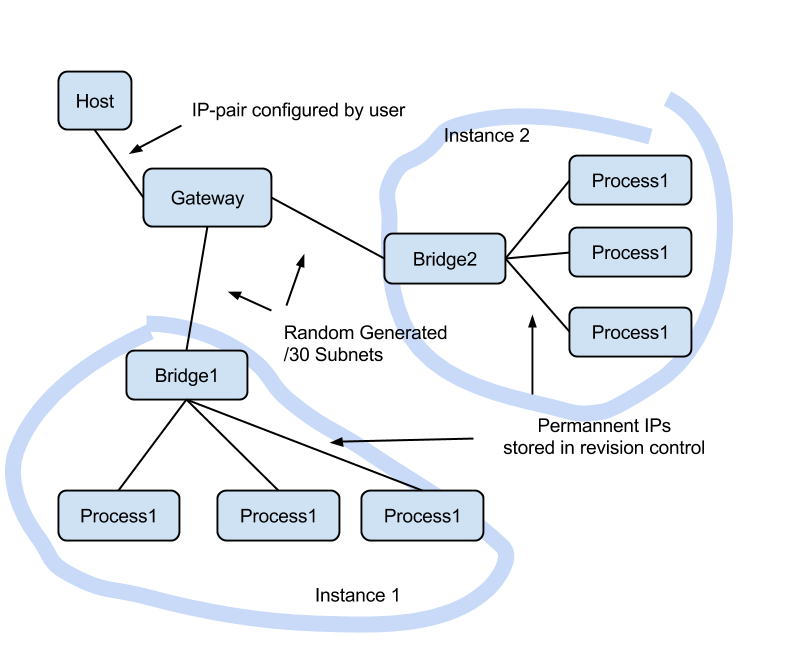Network Testing¶
Usually vagga runs processes in host network namespace. But there is a mode for network testing.
Overview¶
For testing complex networks we leverage !Supervise type of commands to
run multiple nodes. But we also need a way to setup network. What we need in
particular:
- The IPs should be hard-coded (i.e. checked in into version control)
- Multiple different projects running simultaneously (and multiple instances of same project as a special case of it)
- Containers should be able to access internet if needed
So we use “double-bridging” to get this working, as illustrated below:

The Setup section describes how to setup a gateway in
the host system, and Containers section describes how
to configure containers in vagga.yaml. And
Partitioning section describes how to implement tests
which break network and create network partitions of various kinds.
Setup¶
Unfortunately we can’t setup network in fully non-privileged way. So you need to do some preliminary setup. To setup a bridge run:
vagga _create_netns
Running this will show what commands are going to run:
We will run network setup commands with sudo.
You may need to enter your password.
The following commands will be run:
sudo 'ip' 'link' 'add' 'vagga_guest' 'type' 'veth' 'peer' 'name' 'vagga'
sudo 'ip' 'link' 'set' 'vagga_guest' 'netns' '16508'
sudo 'ip' 'addr' 'add' '172.18.255.1/30' 'dev' 'vagga'
sudo 'sysctl' 'net.ipv4.conf.vagga.route_localnet=1'
sudo 'mount' '--bind' '/proc/16508/ns/net' '/run/user/1000/vagga/netns'
sudo 'mount' '--bind' '/proc/16508/ns/user' '/run/user/1000/vagga/userns'
The following iptables rules will be established:
["-I", "INPUT", "-i", "vagga", "-d", "127.0.0.1", "-j", "ACCEPT"]
["-t", "nat", "-I", "PREROUTING", "-p", "tcp", "-i", "vagga", "-d", "172.18.255.1", "--dport", "53", "-j", "DNAT", "--to-destination", "127.0.0.1"]
["-t", "nat", "-I", "PREROUTING", "-p", "udp", "-i", "vagga", "-d", "172.18.255.1", "--dport", "53", "-j", "DNAT", "--to-destination", "127.0.0.1"]
["-t", "nat", "-A", "POSTROUTING", "-s", "172.18.255.0/30", "-j", "MASQUERADE"]
Then immediatelly the commands are run, this will probably request your
password by sudo command. The iptables commands may depend on DNS server
settings in your resolv.conf.
Note
you can’t just copy these commands and run (or push exact these
commands to /etc/sudoers), merely because the pid of the process in
mount commands is different each time.
You may see the commands that will be run without running them with
--dry-run option:
vagga _create_netns --dry-run
To destroy the created network you can run:
vagga _destroy_netns
This uses sudo too
Warning
if you have 172.18.0.0/16 network attached to your machine,
the _create_netns and _destroy_netns may break that network. We will
allow to customize the network in future versions of vagga.
Containers¶
# TBD